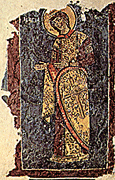 |
|
 |
The Latin dominated areas
 In the regions under Latin rule, artistic activity
In the regions under Latin rule, artistic activity
 was
not influenced by the new political situation. Important information as to the conditions under which churches were built and decorated is provided by their donor inscriptions, the number of which increased considerably during the 13th century. We thus know that representatives of a local higher class, probably small landowners and church dignitaries, are most often the patrons of such programmes. Of particular interest are the cases of collective patronage, in which a whole village contributes to the erection of a church. References to artists, although few, offer us a good deal of information regarding painting workshops and the movements of painters. For example, in 1244, a painter named John produced the wall paintings of the church of the Holy Trinity (Hagia Triada) at Kranidi in the Argolid and later, as we can tell by their stylistic similarity, decorated the church of St John Kalyvites at Psachna in Euboea. Scholars also attribute to John or to his collaborators the frescoes of the church of St George at Oropos, which have been removed and are today in the Byzantine Museum in Athens. These monuments allow us to speak of a local school, known as the "school of Athens" and reveal the way in which artistic trends spread in the wider area of southern Greece. Also very interesting are the references to the Byzantine Emperor, which are found in this kind of inscription, and which have been interpreted as a form of opposition to the Latin conquerors and an expression of the loyalty of the local people towards the figure who, in their eyes, was the rightful ruler. was
not influenced by the new political situation. Important information as to the conditions under which churches were built and decorated is provided by their donor inscriptions, the number of which increased considerably during the 13th century. We thus know that representatives of a local higher class, probably small landowners and church dignitaries, are most often the patrons of such programmes. Of particular interest are the cases of collective patronage, in which a whole village contributes to the erection of a church. References to artists, although few, offer us a good deal of information regarding painting workshops and the movements of painters. For example, in 1244, a painter named John produced the wall paintings of the church of the Holy Trinity (Hagia Triada) at Kranidi in the Argolid and later, as we can tell by their stylistic similarity, decorated the church of St John Kalyvites at Psachna in Euboea. Scholars also attribute to John or to his collaborators the frescoes of the church of St George at Oropos, which have been removed and are today in the Byzantine Museum in Athens. These monuments allow us to speak of a local school, known as the "school of Athens" and reveal the way in which artistic trends spread in the wider area of southern Greece. Also very interesting are the references to the Byzantine Emperor, which are found in this kind of inscription, and which have been interpreted as a form of opposition to the Latin conquerors and an expression of the loyalty of the local people towards the figure who, in their eyes, was the rightful ruler.
|